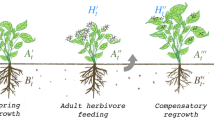Abstract
We present a theoretical analysis that considers the phenotypic trait of compensatory growth ability in a context of population dynamics. Our model depicts a system of three interactors: herbivores and two different plant types referred to as ordinary and compensating. The compensating plant type has the ability to increase its intrinsic rate of biomass increase as a response to damage. This compensatory growth ability is maintained at the expense of a reduced growth rate in the absence of damage, where the ordinary plant type has the higher growth rate. Analysis of this system suggests that, even though a compensatory capacity of this kind will not imply an increase in equilibrium plant density, it will give a competitive advantage in relation to other plants, in the presence of a sufficiently efficient herbivore. Invasion of compensating plants into a population of non-compensating plants is facilitated by a high compensatory growth ability and a high intrinsic rate of plant biomass increase. Conversely, an ordinary plant can invade and outcompete a compensating plant when the herbivore is characterised by a relatively low attack rate, and/or when plant intrinsic growth rate is decreased.
Similar content being viewed by others
References
Belsky, A.J., Carson, W.P., Jensen, C.L. and Fox, G.A. (1993) Overcompensation by plants: herbivore optimization or red herring? Evol. Ecol. 7, 109-121.
Coley, P.D., Bryant, J.P. and Chapin III, F.S. (1985) Resource availability and plant antiherbivore defense. Science 230, 895-899.
Crawley, M.J. (1983) Herbivory -- The Dynamics of Animal-Plant Interactions. Blackwell Scientific Publ., Oxford.
Fryxell, J.M. and Lundberg, P. (1997) Individual Behaviour and Community Dynamics. Chapman & Hall, London.
Herms, D.A. and Mattson, W.J. (1992) The dilemma of plants: to grow or defend. Quarterly Rev. Biol. 67, 283-335.
Holt, R.D. (1977) Predation, apparent competition and the structure of prey communities. Theor. Population Biol. 12, 197-229.
Maschinski, J. and Whitham, T.G. (1989) The continuum of plant responses to herbivory: the influence of plant association, nutrient availability, and timing. Am. Nat. 134, 1-19.
McNaughton, S.J. (1979) Grazing as an optimization process: grass-ungulate relationships in the Serengeti. Am. Nat. 113, 691-703.
McNaughton, S.J. (1983) Compensatory plant growth as a response to herbivory. Oikos 40, 329-336.
Nilsson, P., Tuomi, J. and Åström, M. (1996) Bud dormancy as a bet-hedging strategy. Am. Nat. 147, 269-281.
Rosenthal, J.P. and Kotanen, P.M. (1994) Terrestrial plant tolerance to herbivory. Trends Evol. Ecol. 9, 145-148.
Tanner, J.T. (1975) The stability and the intrinsic growth rates of prey and predator populations. Ecology 56, 855-867.
Tuomi, J., Nilsson, P. and Åström, M. (1994) Plant compensatory responses: bud dormancy as an adaptation to herbivory. Ecology 75, 1429-1436.
Vail, S.G. (1992) Selection for overcompensatory plant responses to herbivory: a mechanism for the evolution of plant herbivore mutualism. Am. Nat. 139, 1-8.
van der Meijden, E. (1990) Herbivory as a trigger for plant growth. Funct. Ecol. 4, 121-129.
Yodzis, P. (1989) Introduction to Theoretical Ecology. Harper & Row Publishers, New York.
Author information
Authors and Affiliations
Rights and permissions
About this article
Cite this article
Järemo, J., Palmqvist, E. Plant compensatory growth: a conquering strategy in plant–herbivore interactions?. Evolutionary Ecology 15, 91–102 (2001). https://doi.org/10.1023/A:1013899006473
Issue Date:
DOI: https://doi.org/10.1023/A:1013899006473




